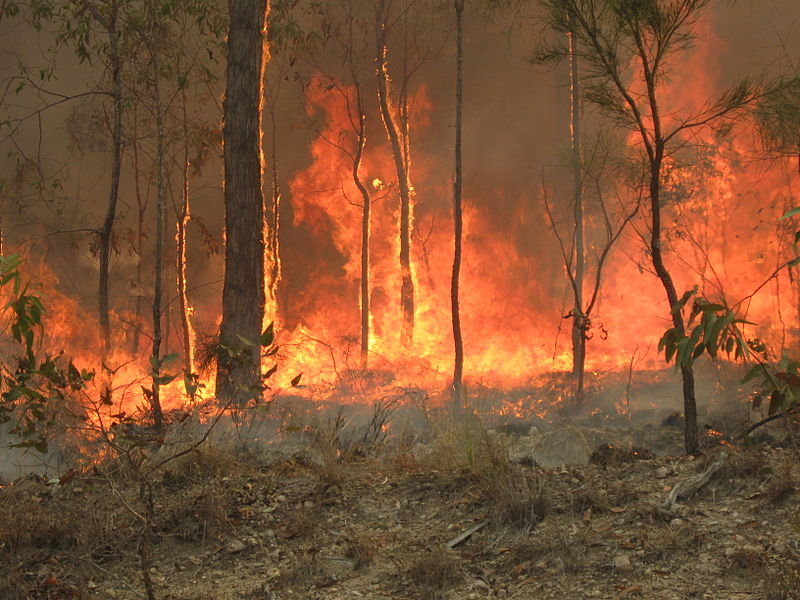How Bushfires Will Affect Australia’s Security
Mid-January rains have quenched the seared Australian landscape, but the world is just beginning to come to terms with the consequences of the blazes—and what the future of fire season may hold.

Published by The Lawfare Institute
in Cooperation With

The 2019-2020 summer fire season in Australia has been devastating. Fueled by record-high temperatures, unusually high winds and prolonged drought, the bushfires have plagued every Australian state and caused the deaths of 29 people and more than 1.25 billion animals. An area the size of Iceland has been destroyed—more than five times the amount of land affected by the 2018 California wildfires. Air quality in Melbourne is worse than in New Delhi and Shanghai, and inhaling the air has roughly the same effect as smoking seven cigarettes a day. While heavy rain on the country’s eastern coast has helped douse some of the fires, fear remains that the worst is yet to come: Fire season in Australia generally lasts October through March, and southern states tend to feel the worst of the blazes later in the season.
Besides the obvious loss of life, natural resources and habitat, the bushfires will have extreme consequences for Australia’s security, economy and international relations going forward. And the country’s ability to respond effectively to bushfires will be critical for decades to come.
Climate Change, Environmental Impacts and International Relations
While Prime Minister Scott Morrison and his government have attempted to dismiss the connection between the current fires and climate change, scientists have recognized the connection for years. Australia’s climate has warmed about 1 degree Celsius over the past century. Shifting precipitation patterns have decreased rainfall in the country’s southeast, where a majority of the bushfires have been located. A recent review of the scientific literature found that the changing climate increases the frequency and intensity of “fire weather”—periods of high temperatures, low humidity, low rainfall and strong winds, which lead to increased fire risk. These changes are occurring not only in Australia, but worldwide, as the 2018 California fires and the 2019 Amazon fires demonstrate.
This graph, from the Australian Bureau of Meteorology’s 2018 State of the Climate Report, shows Australia’s rising surface air temperature from 1910 to present day.
Australia’s history with climate change has been complicated. While the country has sometimes taken early initiative and innovative action, it has long lagged behind other developed countries in the fight against climate change and has a history of denying the connection between the burning of fossil fuels and the climate emergency. Even in the face of the current fire season, Morrison has stated that the country will focus on resilience and adaptation to “prepare practically” for fires in the future but will not revisit its climate change mitigation policies. Indeed, even as the fires raged on, Australia was a key player in the breakdown of the climate talks in Madrid last month: The Australian delegation stated that the country would use previous credits under the Kyoto Protocol to count as emissions reductions to meet their Paris Agreement targets. This “loophole” has the effect of Australia “fulfilling” 90 percent of its reduction targets with credits it received before the Paris Agreement was even designed—a move that other countries consider out of touch with the commitment and spirit of the agreement.
The clear link between climate change and current fires could increase tension between countries affected by Australian fires. Scientists have predicted that the release of carbon dioxide from plants burned in the fires is likely to be responsible for up to 2 percent of the annual increase in atmospheric carbon dioxide worldwide for the current year. And the fires will add to increasing carbon dioxide in future years, too, as the destruction of the forests—which store and absorb carbon dioxide—takes away an important carbon sink going forward. For Australia to continue to ignore the climate problem, when the consequences like the bushfires are felt across the region, could easily be seen as acting in bad faith toward the country’s international allies—especially considering the effects of climate change, like rising sea levels and ocean acidification, on Pacific Island nations. Pacific leaders have already pointed out Australia’s hypocrisy in providing funds for climate adaptation and migration paths for affected islanders, while continuing to ignore Australia’s own contribution to climate change.
But climate change is not the only environmental disruption caused by the bushfires. Smoke and air pollution from the fires have traveled across the ocean, affecting New Zealand and other small island states nearby. These countries, whose economies largely depend on a robust tourism industry, will see concrete effects from the fires: Early in January 2020, tourists in New Zealand posted photos showing how the pollution from the bushfires had turned the snowpack yellow and enveloped the entire region with a smoky haze, and they commented on the burnt smell that had been drifting over the country for days. Additionally, breathing in the smoke and pollution from the fires will have long-term health effects on those exposed to it and have already increased hospital admissions in Sydney by more than 10 percent.
While allies have been quick to volunteer service members and resources to combat the fires that could affect their nearby countries, the Australian government’s lack of action on prevention and mitigation could strain its relationships with surrounding countries that want and need Australia to do more for the region’s climate security.
Military Security
The Australian government has faced widespread criticism for its slow response to the bushfires, claiming in September that this fire season would be like any other. Typically, state and territory governments are responsible for firefighting, which is conducted by an entirely volunteer workforce; this year, the New South Wales Rural Fire Service, the largest volunteer fire service in the world, has been on the front lines of many of the bushfires. Finally, in early January, Morrison announced the government would send military troops to assist the firefighters, in the largest deployment since World War II.
The Australian Defense Force (ADF) website clarifies that the “ADF is not trained, equipped or certified to undertake ground-based or aerial bush firefighting and does not get involved in the direct act of fighting bushfires.” Yet the military has been a critical asset in battling blazes in the past month. While the ADF is technically available only to support state and territory governments in fighting fires, this year’s fires have required 6,500 troops from the ADF, including 3,000 reserve troops, to be deployed to work alongside local civilian authorities. These troops have assisted in evacuations, clearing roads, operating emergency medical facilities, disposing of animal carcasses, felling and removing unsafe trees, delivering clean water and food, and maintaining containment lines.
Likewise, the government dispatched the navy to help evacuate people in Victoria, the Royal Australian Air Force has been transporting firefighters and equipment between interstate locations, and more than 350 members of neighboring states’ militaries have been brought in to assist with the ADF’s efforts. Ships, helicopters, tanks and aircrafts have been redirected from routine military activities to assist in containing the bushfires and aiding affected populations.
The ADF itself is not an emergency or disaster relief force, but an organization responsible for the national defense of Australia. Yet for the last month its main effort has been providing direct support to the bushfire crisis. Retired Australian Army Gen. Michael Thomas has argued that climate change has and will continue to shift the type, locations and frequencies of the crises the ADF must be prepared to respond to, which will require additional training and resources. The military, according to Thomas, must rethink its strategy to better equip itself to respond to multiple and simultaneous climate catastrophes, and include measures to allow the military to better adapt to and mitigate climate change.
The extraordinary national and international response to help combat the fires has been nothing short of necessary. However, the use of military resources to fight fires has the potential to leave military capacity strained elsewhere. If the current level of ADF involvement is needed year after year to respond to fire season, what would happen in the face of another, traditional national security emergency? Up to this point, Australia has relied primarily on local, volunteer firefighting services—yet the extreme need for military aid this time around signals that a more institutionalized and well-financed method of fire control and firefighting may be necessary to keep Australia safe from both military threats and natural disasters.
Economic Stability
Morrison had promised that his government would bring in a budget surplus in 2019-2020. But that promise has been scaled back as the fires continue to damage property and livelihoods across the country, and Morrison has proposed government spending of more than $2 billion to help the country recover.
More than 72,000 volunteer firefighters have taken time away from work to fight the bushfires, further disrupting the economy as businesses lose employees to the firefighting efforts. The drastic disruption in forest ecosystems will cause significant job loss and long-term economic damage in pulp, paper, timber and bioproducts production, according to the Australian Forest Products Association. Consumer confidence in the Australian economy fell to a four-year low in January, signaling the hesitance of Australians to trust the economy in the coming months. Economists have estimated that the bushfires in Australia will lower the country’s March quarter gross domestic product (GDP) between .01 and .02 percentage points. Total costs are likely to exceed US$3 billion, and overall GDP growth estimates have dropped by 0.3 percent.
The $2 billion relief package allows businesses to access grants of up to $50,000 and loans of up to $500,000 if they have experienced significant loss of revenue or assets from the fires, and it includes $100 million dedicated to assisting farmers, fishers and foresters. Additionally, it contains a $76 million Tourism Recovery Package, to help the fire-ravaged southern towns that depend on tourists from the global north visiting during their winters. The government has also enacted an automatic two-month deferral period on taxes and suspended debt recovery from welfare recipients to attempt to lessen the economic burden on low-income families caused by fires.
But the initial recovery spending is just a portion of the money that will be spent by the government, private companies and citizens in recovering from the fires. Insurance claims from the fires are already totaling more than $1 billion and are likely to increase. And replanting of the forests and rebuilding of infrastructure will take a huge amount of time, money and effort.
With fire season not yet over, the country will have to wait several months before it can truly assess the damage done this season, but the extreme costs both domestically and internationally are already apparent. The question is how Australia responds. One possibility is already on the table: In response to the fires, Independent Member of Parliament Zali Steggall, who unseated Prime Minister Tony Abbott in the 2019 elections largely on an agenda of climate action, has proposed a bill to set the framework for reducing carbon emissions and adapting to climate change impacts. It’s not clear how much support her bill will find from other members, and it’s likely to be met with resistance from Morrison’s coalition government. But as the smoke clears in the coming months, Australians and their government will need to consider what comes next.





